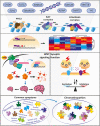The phenomenal epigenome in neurodevelopmental disorders
- PMID: 32766754
- PMCID: PMC7530535
- DOI: 10.1093/hmg/ddaa175
The phenomenal epigenome in neurodevelopmental disorders
Abstract
Disruption of chromatin structure due to epimutations is a leading genetic etiology of neurodevelopmental disorders, collectively known as chromatinopathies. We show that there is an increasing level of convergence from the high diversity of genes that are affected by mutations to the molecular networks and pathways involving the respective proteins, the disrupted cellular and subcellular processes, and their consequence for higher order cellular network function. This convergence is ultimately reflected by specific phenotypic features shared across the various chromatinopathies. Based on these observations, we propose that the commonly disrupted molecular and cellular anomalies might provide a rational target for the development of symptomatic interventions for defined groups of genetically distinct neurodevelopmental disorders.
© The Author(s) 2020. Published by Oxford University Press.
Figures


References
-
- Cavalli G. and Heard E. (2019) Advances in epigenetics link genetics to the environment and disease. Nature, 571, 489–499. - PubMed
-
- Vecsey C.G., Hawk J.D., Lattal K.M., Stein J.M., Fabian S.A., Attner M.A., Cabrera S.M., McDonough C.B., Brindle P.K., Abel T., Wood M.A. (2007) Histone deacetylase inhibitors enhance memory and synaptic plasticity via CREB: CBP-dependent transcriptional activation. J. Neurosci., 27, 6128–6140. - PMC - PubMed

